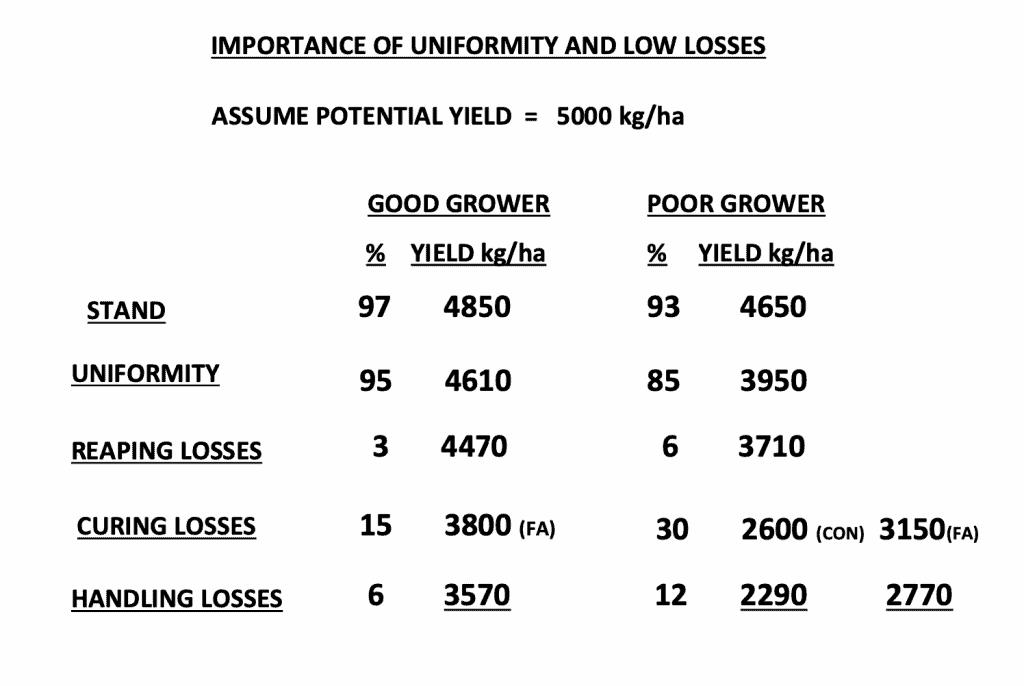Agronomy Notes – Achieving Yield 2015-16 season

The past season has been particularly difficult for most growers. Prices were static and yields static or down. This means therefore, that most people will be starting next season “on the back foot”. Often growers look for the “magical bullet” to improve their situation. This might be a new variety, fertilizer, a chemical, perhaps a “snake juice” that they have heard of at the bar, sports field or school. Unfortunately this approach often creates a false impression and usually results in disappointment, particularly if the vital ingredient in successful tobacco production is ignored, namely attention to detail.
TRB Research done in the 1970s in the Marondera and Karoi areas clearly demonstrated the importance of correct planning and management in successful tobacco production. When comparing high yielding growers with low yielders, it was found that high yielders prepared lands earlier and more efficiently, planted earlier (dryland), placed fertilizer more accurately, ensured early weed control, topped earlier and reaped on time. Later work on field to floor losses (1980s) highlighted the decline in yield caused by poor land selection and preparation and indifferent planting management. This research also showed how field to floor losses were reduced by correct fertilizer management, particularly that of nitrogen; good sucker control and, most importantly the correct planning of barn capacity i.r.o. maximum ripening rate. Growers with low losses had sufficient barn space to ensure that NO leaf was lost at peak ripening, whereas those that experienced high losses often had as low as half the amount of barn capacity at the critical stage. This resulted in losses from being forced to reap overripe leaf, overpacking, high curing losses, and insufficient conditioning time, increasing breakage and storage mould problems.
It is glaringly obvious that a return to the “BASICS” of flue-cured tobacco culture is vital to achieve the necessary correct crop establishment, early uniform development, vigorous grand growth and low losses (both before and after reaping) that are essential in achieving high yields.
In the following examples the losses quoted are the extremes determined by research. Losses experienced on farms are unlikely to be as severe. Nevertheless, it serves to illustrate the magnitude of problems that can arise.
Crop Establishment and Uniformity
- Soil protection – ensuring correct designed contours, waterways, roads and storm drains is necessary, but more importantly the biological health of the soil is vital. Continuous cropping of tobacco soils leads to severe depletion of organic matter resulting lowering fertility and water holding capacity. With land use restrictions traditional tobacco rotations are difficult and therefore alternatives such as green manuring with various legumes and cereals as well as winter and summer cereals must be considered. The essential aspect is to ensure the return of organic matter to the soil.
- Correct Land Selection must be done to achieve a uniform crop. Whenever possible, avoid atypical soils such as vlei margins, gravelly areas, antheaps, weaker soils etc. Poor conservation, rotation and land selection can reduce yield by up to 25%.
- Land preparation must be timely, uniform and appropriate to the situation. This generally means that it should be done early but if soils dictate late preparation because of fertility, early ploughing may lead to black tobacco and hence high losses. Also ridging must ensure that fertilizer placement is accurate and uniform. Inaccurate fertilizer placement was found to reduce yield by 15%.
- Fertilizer management – soil analysis is essential in establishing the nutritional “health” of the soil. This is particularly important in the case of pH as, if too low or too high, it has a significant impact on availability of other nutrients. Low pH will reduce yield by 26%. Soil analysis results also provide accurate information on major nutrient availability such as phosphate and potash. Compound fertilizer rates must be determined using correct soil analysis results rather than “gut instinct”. Flue cured tobacco is particularly sensitive to nitrogen mismanagement, and in some circumstances as little as 10 to 15% too much nitrogen can lead to lower yields (black tobacco, substantial increase in disease etc).
- Correct planting management is fundamental to high yields. Seedlings must be the correct size, properly hardened and there must be sufficient to ensure uniformity. All too often seedlings tend to become substandard towards the end of planting, simply because not enough beds were sown. Seedbed costs are a small fraction of overall cost of production and therefore increasing seedbed area by 20 to 30% is insignificant. Seedlings must be protected both physically (from heat and desiccation) and biologically (insects and diseases). The planting operation requires training and supervision if it is to be done correctly. Poor stands and uneven growth may reduce yield by 25%.
- Crop Protection from nematodes, weeds, insects and diseases must be timely and appropriate. Reliance on a one-dimensional approach e.g. chemicals only, often leads to increased problems later – Integrated Pest Management (IMP) is essential. Inadequate nematode control may results in a 71% loss, poor weed control in the 1st 5 weeks after planting 65%, severe insect damage 60% and serious disease up to 95% reduction in yield.
- Early (bud) topping and complete sucker control are vital to both uniformity and low losses. Research illustrated that for every day topping is late, yields may decline by 1% and poor sucker control will reduce yield by up to 35%.
Reaping, Curing and Handling
- Reaping management and training must ensure that reaping uniformly ripe leaf is done. A system that discourages green reaping (e.g. area reaping) is preferable. Land layout and road design must be such that reaped tobacco is protected from desiccation and physical damage. Reaping one reaping overripe can reduce yield by up to 20%.
- Curing planning and management must ensure sufficient curing capacity for maximum ripening periods. (Note that if this is the case, there will be no problem ensuring that ripe leaf only is reaped). Curer capability must match yield expectation. As an example, at an expected yield of 2 500 kg/ha a standard barn may have a capability of 60 000 leaves, but if the potential yield is 3 500 kg/ha that barn will only handle 45 000 leaves i.e. DO NOT overload the barns! Many growers have upgraded curing facilities to some form of forced air systems with significant reduction in potential curing losses. Nevertheless, if the capacity of these facilities is exceeded, curing losses will mount up and the TRB Research done in the 1970’s and 80’s clearly demonstrated that curing was where the potential loss is highest. Curing losses of up to 45% have been measured in inefficient barns.
- Curing capacity also impacts on Handling because there must be sufficient time to condition the cured leaf correctly. Correct planning and management of storage and grading is imperative in minimizing losses both from breakage and storage mould. Handling and grading losses of up to 12% have been measured.
The following table illustrates the importance of correct planning and management. This data has been drawn from research outlined above. The potential yield is determined by variety and climate and is considered to be an average representation of a dryland crop in a medium growing area in a good year. Obviously this potential will be higher for the irrigated crop, in dry years and in slow growing areas. Conversely in the northern areas, especially in wet seasons it may be lower.
The percentages represent the incremental losses determined for each aspect of the cropping process. Loss of population in the land (Stand) was found to be around 3% for the better growers and in many cases above 10% for low yielders, with an average of 7%. Uniformity includes the broad range of managerial aspects outlined above and the range for better growers was 10% (best to worse potential yield in the land) with an average of 5%. Poor producers had uniformity variation of up to 30%, hence the average of 15%. Generally poor growers lost twice as much leaf during Reaping as compared to good growers. Curing losses occur as a natural function of the process and are unavoidable. The trick is to minimize these losses without compromising quality. Depending on season, natural curing losses will range between 12 to 18%. In this example good growers using forced air (FA) curing facilities experienced losses of 15% whereas the poor grower with conventional barns (CON) had losses double this. If the poor grower used FA it was assumed that losses would be 15%, although this may be debatable, considering earlier crop management history. (It is important to note that FA is not necessarily the panacea to reducing losses, many good growers use conventional curing facilities successfully – it depends on understanding the weakness of the system and planning accordingly). Handling losses (curing to floors) achieved by the better grower is half that of the low yielder. The final yield figure (underlined) represents the sold yield in each case. In the research it was found that the good grower also produced better quality and therefore is likely to achieve a higher price.

The important factor in this example is that losses are progressive and accumulative. This means that one cannot look at each management component in isolation, it has to be looked at holistically, i.e. the consequence of one action will impact on the next and so on.
Of interest is that although research results are used to create the yields in the example, the final yields are similar to those achieved on farms. The question for the grower then, is what category do you fall into? Under the present situation the good grower may be marginally viable. With forced air (FA) the poor grower may be able to cover costs of production, but with very little left for overheads, whereas without forced air even production costs will not be covered.
